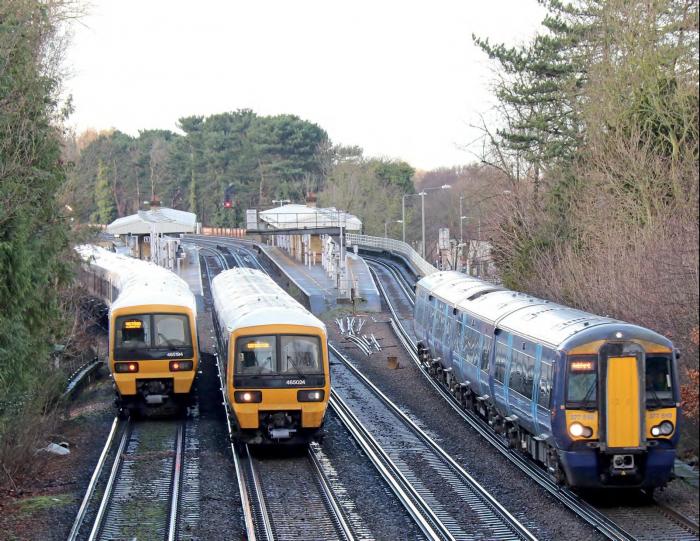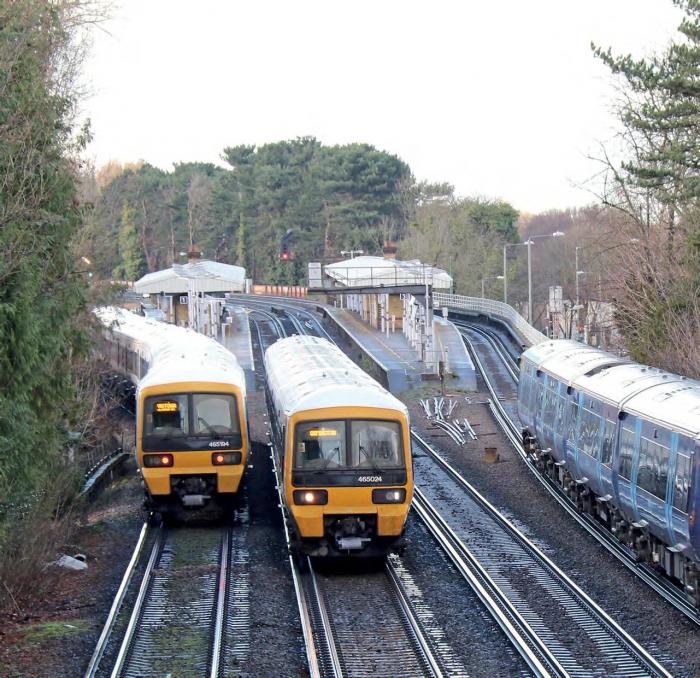
Accessible ‘single source of truth’ is key to Traffic Management
TRAFFIC MANAGEMENT SPECIAL
For Southeastern, 12 February 2016 was ‘black ice Friday’. Rain after a freezing night created a particularly severe case of ice coating the traction current conductor rails as the morning service began.
In the Kent Integrated Control Centre (KICC) the 13 managers on duty (four train service managers, four resource managers, the operational communications and information delivery managers plus the three-strong information team) were swamped. Train service managers were handling up to 40 phone calls an hour.
Reactionary delays and cancellations continued throughout the day, maintaining the workload on the KICC floor. By the end of the day Southeastern had accumulated 15,588 delay minutes.
An experience like that burns into an operator’s soul. Something had to be done and the result was the development of a new computer-based Operations Control System (OCS).
There is no shortage of information in the various operational systems used on the railway: TOPS for rolling stock, TRUST for train reporting, DARWIN for information. But these slick acronyms betray the fact that they date back to British Rail – TRUST from the 1970s, for example.
This disaggregation means that none of the legacy systems holds sufficient real-time information to act as a single point of reference for operational teams, both centrally in KICC and at local stations.
Having to consult several sources to make a decision, which may in turn affect an evolving situation, can mean that control staff are forever playing catch-up.
What was needed was ‘a single source of truth’. A common system all operators could use to manage the operational plan in real time.
Integration would also eliminate the need to re-enter data. Similarly, information should be provided to downstream systems, such as DARWIN, the national train running information database, which takes feeds directly from every train operating company (TOC), plus intranet pages for staff.
FEATURES
Three sets of data needed to be integrated: timetable/train planning; rolling stock diagrams; and train crew diagrams. The latter two are known colloquially in the Traffic Management world as ‘Stock & Crew’.
Tracsis was awarded the contract to supply and integrate the systems using proven systems. These are the Attune4C timetable editor, developed by software house Bellvedi, recently acquired by Tracsis, and TRACSEnterprise – Tracsis’ own stock and crew editor.
Attune4C’s unique selling point is that Bellvedi, founded in 2013, invested in encoding all of Network Rail’s train planning rules. These are contained in a large printed document. Typical rules cover headways, Sectional Running Times and junction planning.
TRACSEnterprise provides two facilities. The Resource Management module provides one source of data for all human resource planning and work allocation. Rail-specific features include managing skills and skill retention. It can also highlight potential violations of working terms and conditions, including fatigue.
Complementing Management is Resource Planning. This covers the management of individual resources – both rolling stock and crew – from weekly rostering through daily planning and on-the-day operations.
For the SE OCS the key functions are rolling stock planning, train crew shift planning and real-time management of stock and crew. A live interface with the Attune4C timetable editing facility is also provided.



ATTUNE4C
Traffic Management systems include the ability to work offline. Applications range from testing Very Short Term Plans to contingency planning. Tracsis calls this facility ‘sandboxing’, a reference to the children’s play area.
Using the sandbox you can take a copy of the current situation, resolve specific issues and then ‘publish’ the revised plan back into the live system.
As with other Traffic Management systems, Attune4C works through a series of screens. For example, the ‘trains and stops’ view provides a split screen, one half lists all trains, colour coded in order of lateness. From this list a specific train can be selected with its current location, stopping pattern, arrival and departure times, lateness and other information displayed in the other half of the split screen.
From this view you can switch to the train graph where the selected train is highlighted with lateness projected forward. The graph retains the lateness colour coding of the trains and stops list, with green indicating right time, yellow, more than one minute late, red six to 10 minutes and purple more than 20 minutes.
A third screen provides an overview of the complete Southeastern network, with the location of trains shown, and also colour coded. This is similar to the CCF (Control Centre of the Future) display, widely used in control centres.
In this view Attune4C highlights the path of the selected train, with revised forecast stopping times shown. Booked timings can also be displayed.
EDITING
Returning to the trains and stops screen, this provides tools which allow the train plan to be edited. On the List section of the split screen, groups of services can be selected and manipulated, in a similar way to the single train view.
For example, a ‘nudge’ feature can be used to move a train a couple of minutes earlier or later.
Other options include cancelling, terminating short, starting forward and changing stations on the route to a stop or a pass.
A demonstration of Attune4C began with the transfer of a late running train to the sandbox. In the case of the selected late running train it was decided to omit two stops. The two stations were selected and the pass–through applied.
When the sandbox is published to the live timetable, the station simplifier is modified accordingly. Thus the staff at the affected stations know that that the train is now not stopping.
This information is ‘pushed out’ automatically. DARWIN and passenger information systems are updated with no need for manual intervention on the Control floor.
MORE DETAIL
In specifying OCS, SE took the opportunity to add additional details to the basic running data for each train. This includes the names of the crew, the unit diagram and the unit number.
A further refinement is the names of any crew travelling as passengers on a train to their next duty. This checks that cancelling a train will not stop a driver getting to their next duty!
Also shown on the display for terminating trains is ‘crew in and out’. While most trains will arrive and depart with the same crew, in some cases there may be a change of conductor, for example.
This facility allows the local co-ordinator to see any potential gaps in coverage where trains are not allowed to run without a conductor. Should a replacement crew member be needed, this prompts a check that the person is ready to take over.
Currently such a check would mean consulting several documents plus a phone call to Control. Now the information is all in one place.
According to Andy Toplis, Southeastern’s Senior Programme Manager responsible for the OCS project, the response from station staff has been ‘99.5% positive – the other 0.5% want more features’! Mr Toplis summarises it as ‘a one stop place to look at every station’.
DIVERSIONS
Another facility is handling diversions. If there is a problem at a particular location, the list can be filtered to show only trains passing through Orpington, say, in the next 20 minutes.
FIGURE 1: CARRIAGE WORKING SCREEN


Using the system, Mr Toplis diverted a train round the Catford loop. Attune4C showed it would be four minutes early on arrival at Shortlands to take up its original path.
I wondered how you could be sure that the diversion would not interfere with other services. Consulting the train graph showed plenty of ‘white space’.
While Control would need to phone the signaller for permission to route the train down the Catford loop, once the move was approved, it could be published to the live system, all the station simplifiers on the original route would display ‘train not calling here’, while it would be shown as an additional service at stations on the loop.
As Andy Toplis puts it, ‘The new operational plan is visible to all’.
As with other TM systems, Attune4C can also be used as a planning tool. The fact that it incorporates the rules means that it will highlight any infringements, for example platform occupation times.
Andy Toplis pointed out the ability to develop and publish a temporary timetable in minutes, for example in the event of a line closure. Once the revised timetable has been produced in the sandbox, it can be e-mailed to the local signallers and circulated to other staff.
When planning future timetable changes, Southeastern will be able to submit a much more robust timetable to Network Rail. Although not strictly relevant to this article, I was also shown how Attune 4C can be used to develop an entirely new timetable. For example, it is possible to specify the calling pattern for a new service with the reverse working being introduced automatically. This can then be repeated at a regular interval. The ability to manipulate groups of services, the handling of platforming, and facilities such as the automatic generation of headcodes, make this a powerful tool. It is already being used by Network Rail’s timetabling centre at Milton Keynes.
STOCK & CREW
TRACSEnterprise integrates train operation with stock and crew information, bringing together current paper-based systems, not least the Carriage Working Notice.
First to be demonstrated was the carriage working screen (Figure 1).
When a station is called up the screen shows the ‘resource’ (trains), with the class numbers of the units forming a service in the central column.
To the right are the details of the incoming service. This shows this list of information: the diagram, where the train has come from, arrival time plus late/early, the headcode and the identification codes for the crew.
On the left of the screen are similar details for the outgoing service. For example, at Hastings No 375108 arrived three minutes late as RM61 from the carriage sidings driven by TG1708. It then formed 1H70, the 08.17 to Charing Cross with TG1809 joining as conductor.
CHANGE
Units can be changed to a new service in real time, for example, stepped-up. The change is then implemented automatically across the Tracsis system.
For example, where a train may now complete its diagram at a different location, the ‘single source of truth’ concept means that the maintenance controller is provided with this information. If necessary, further action can be taken to ensure the unit arrives at the planned depot.
Previously, such stock changes would have been recorded manually during the day. With this new system, each change is tracked and at the end of the day the final duty and destination can be fed into the asset management system.
Restrictions can also be imported from the asset management system, for example, a train may be limited to multiple-unit operation only. This is flagged up on the stock screens.
CREW
TRACS provides a database of the diagrams for drivers and train crew.
This shows signing-on and off times, the type of shift – early, very early, late or very late – plus any ‘issues’, indicated by a numerical code. For example, very early shifts are shorter.
This information is imported from the rostering system each morning.
Calling up a driver from the list on the screen shows the trains to be worked during the shift and when a break is taken. There is a sophisticated filtering system which allows groups of data to be selected – for example, all driver rosters at a specific depot.
Rather like Attune4C, this system enables perturbations to be managed in real time. For example, if a driver phones in sick, their work can be allocated to a spare. The system checks for location and availability automatically. When the spare driver signs on, the system has also produced a pdf of the new duty.
Similarly, if a signing-on time change changes the category of shift from very early to early, the system automatically adjusts the permitted hours. Also, if a driver signs in and there is no immediate work, they are allocated to the spares pool at that depot automatically.
Currently traction knowledge is not one of the criteria. While Tracsis could provide this in its rostering facility, this was not part of the specification due to time constraints within the then Direct Award. Another facility is the ability to create a new diagram and allocate the required train crew.
This is particularly valuable in the event of a major perturbation – a line closure due to a landslip, for example, complementing the ability to create an emergency timetable with Attune4C
FUTURE DEVELOPMENTS
Attune4C went live in October, providing the station working simplifier and the static CWN for the Highspeed and rural services workstation covering all Class 395 services plus the Sittingbourne to Sheerness and Medway Valley lines.
TRACSEnterprise is due to follow by the end of the year. But as we are finding with Traffic Management, once you have a working system you can expand it progressively. Here connectivity is the key.
For the Southeastern project, planned developments include automatic production of a signaller’s simplifier, a link to rolling stock management systems plus, of course, a connection to the railway’s LINX communication system. Another feature Andy Toplis wants adding to the crew resource is live mapping of driver availability at depots. If a service is cancelled, the crew will have ‘dead time’ when they could be reallocated to another duty.
Currently it is hard to keep track of such changes when Control is busy managing disruption; real-time listing of the hours available would improve crew utilisation. Andy Toplis sees this as one of the major business benefits of the new system.
Also being developed at the time of my interview was ‘exception reporting’. Rather like a train graph highlighting future conflicts, this will provide an alert where a train has no driver rostered. Rostering is based on a set of rules, such as maximum hours.
This could mean that the nominal shift ends 30 minutes before a train arrives at its destination. However, a driver may be happy to work half an hour’s overtime: the roster can be adjusted accordingly
